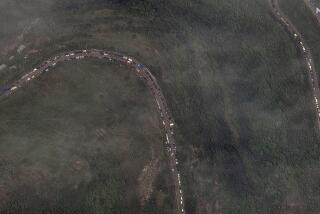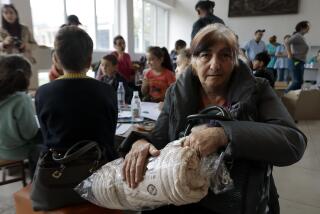Soviet Quake Halts Gorbachev Trip : He Flies Home Today; Thousands Feared Dead in Armenia
- Share via
NEW YORK — A massive earthquake struck the Soviet Union’s southern republics of Armenia, Azerbaijan and Georgia on Wednesday, prompting President Mikhail S. Gorbachev to cut short his visit to the United States and return home five days early.
Soviet Foreign Minister Eduard A. Shevardnadze told a news conference that Gorbachev will fly back to Moscow today, canceling the last day of a three-day stay in New York and scheduled visits to Cuba and Britain.
“In the Armenian Republic, thousands of people have died,” Shevardnadze said. “Despite the fact that all necessary measures are being taken . . . Mikhail Gorbachev believes that when a people is suffering, he has to be there and he himself has to lead the efforts.”
Speculation on Return
The sudden change in plans prompted speculation that Gorbachev might be returning to Moscow because of opposition to his program for internal reform, including his decision, announced on Wednesday at the United Nations, to reduce the size of the Soviet armed forces by half a million troops and thousands of tanks.
But Shevardnadze dismissed a reporter’s inquiry on the subject. “I am sorry to say this, but this is not a serious question,” he said.
“If we did not go back now, that would be immoral, and that would be impossible to understand in the situation,” he added.
Shevardnadze said he did not have many details on the earthquake or a reliable death toll, but he repeated solemnly: “Thousands of people have died.”
He added that he understood that the temblor measured 8.0 on the Richter scale at its epicenter in Armenia near the republic’s capital city of Yerevan. The U.S. Geological Survey in Golden, Colo., said it estimated the strength of the quake at 6.9. An aftershock measuring 5.8 followed less than five minutes later, Geological Survey officials said.
By contrast, an earthquake in Los Angeles on Oct. 1, 1987, that measured 5.9 on the Richter Scale left three dead and scores injured.
Shevardnadze said he had been told that nuclear plants and chemical factories in Armenia had not been damaged.
He said Gorbachev is canceling all his scheduled events and will leave New York by noon today. The Soviet president, who addressed the U.N. General Assembly and met with President Reagan and President-elect George Bush on Wednesday, had been scheduled to fly to Cuba on Friday and visit Britain on Monday.
Shevardnadze said Gorbachev will probably fly on from Moscow to Yerevan to direct relief efforts in Armenia.
Gorbachev and his aides learned of the quake Wednesday morning and received further details after the Soviet president’s address to the United Nations, but did not learn how high the death toll might rise until Wednesday evening. Earlier reports from Moscow estimated the death toll at about 200 people.
A scientist at a seismic station in Yerevan said he visited the disaster area and estimated that the death toll probably would run into the thousands.
There were five confirmed deaths--three women and two children--in eastern Turkey, according to officials there.
The official Soviet news agency Tass called it the strongest earthquake to hit the Caucasus Mountains in 80 years.
The U.S. Geological Survey said the quake was centered near the Soviet-Turkish border between Tbilisi, the capital of the Georgian republic, and Leninakan, Armenia’s second-largest city with 200,000 people.
Soviet Foreign Ministry spokesman Gennady I. Gerasimov, who was accompanying Gorbachev on his U.S. visit, earlier said the quake caused “considerable loss of life.”
“A small village has practically disappeared from the face of the earth,” Gerasimov said, but he did not identify the town.
Although most Soviet officials did not give specific numbers of dead or injured, Tass used the sort of language that indicated the death toll could be very high.
“There was much devastation and casualties reported from several districts of Armenia,” it reported, adding that the cities of Leninakan and Kirovakan, the republic’s third-largest city with 165,000 people, were the hardest hit.
State-run Soviet television, in an unusually prompt and detailed report from the scene, showed film of crumbled buildings in Kirovakan and Spitak, a regional center of Armenia.
More to Read
Sign up for Essential California
The most important California stories and recommendations in your inbox every morning.
You may occasionally receive promotional content from the Los Angeles Times.














